I got sidetracked when I took an R3000-XR apart and realized that I could get
TWO of the switchers into the UPS. That led me to test it for battery drop
out characteristics, after which I realized I could make a self-contained,
fairly light, 3kVA system for the Prius. I'm still considering system "B"
with the five 24V switchers and the battery charging capability, but I decided
to get this running first.
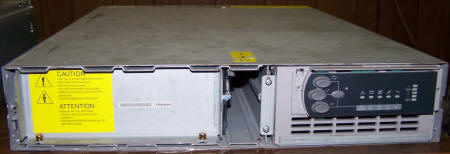 |
The HP/Compaq R3000 XR is a 3000KVA UPS in a 2U package. It's
touted as using DSP to create the output waveform, and if you look
inside the unit you will find no large iron transformer as there is in
the smaller R1500XR UPS from the same manufacturer. This unit runs
on a 120V battery pack instead of the 48V of the R1500XR. |
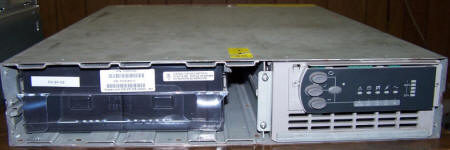 |
I've removed the battery pack cover to have a look inside. |
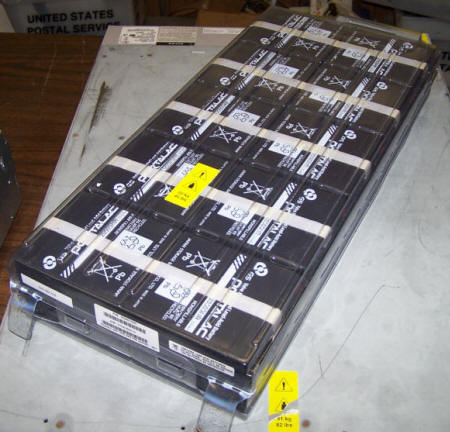 |
The battery pack, a set of ten 12V, 5AH batteries is mounted in its
plastic tray with doublesided stickytape. It's very hard to take
it apart to replace the batteries, and the pack is sold as a unit.
It's not, however, impossible to take it apart, and the batteries are
available from other sources. I was lucky in that this unit,
purchased on eBay, had a good set of batteries. Therefore, I
decided to leave the pack as-is, and be careful that any modifications I
did to the main unit could be easily reversed just in case I actually
wanted to use it as a UPS some day!
The battery pack accounts for more than half the weight of the UPS,
so it's best to remove it. I did some careful testing and found
that the UPS would run until the batteries reached a voltage of 96V, at
which time it would drop out. |
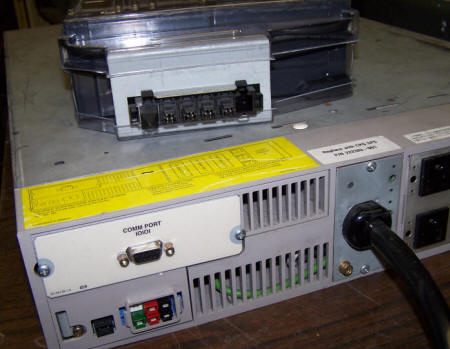 |
Here's a rear view of the battery pack on top of the UPS itself,
also showing the Anderson Power Pole connectors on the rear of the
electronics module. To use the UPS with an external DC power
supply, you can simply connect it to the black and red connectors. If
you use the other scheme - the set of five 24V 50A power supplies in the
"large system" photos, you can also leave the battery pack in the UPS
and they will charge the battery as well. |
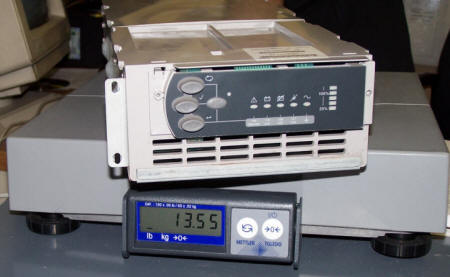 |
The complete 3000VA inverter weighs only 13-1/2 pounds. DSP at
work! The remaining parts on the chassis are only for power
connection - AC sockets, relays and the like. |
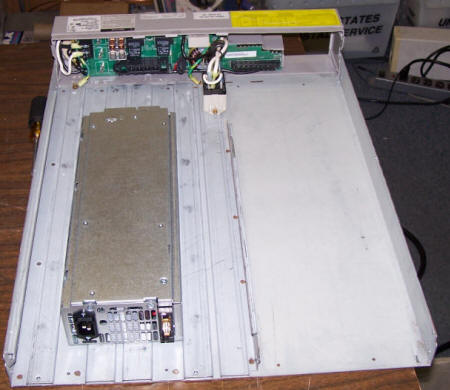 |
Here's the R3000-XR chassis with the battery and electronics module
removed. The single Cherokee switching supply is shown for scale.
Along the left side of the chassis is the battery guide rail. In
order to get two supplies to fit, this has to be removed. Once it,
and another guide rail on the top of the clamshell are removed, there is
precisely enough room to install two of the Cherokee supplies, with
exactly the right clearance. It's almost as if the UPS was
designed with this in mind!
Murphy in reverse - this will probably turn out to be my lifetime
supply of sheet metal charisma. |
 |
I drilled out and saved both the side and top rail. They can
easily be screwed back in if I need to reconvert the UPS to normal
computer-room use. |
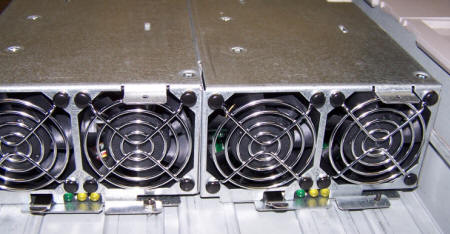 |
The two Cherokee supplies are constrained left, right, top, and
bottom by the coincidental exact fit. I drilled a hole in the
bottom of the UPS chassis for each supply and inserted a captive screw
that goes through the power supply tab left over from removing the
ejector handle. This is the only mounting necessary, and it keeps
the switchers from sliding forward or to the rear of the UPS chassis. |
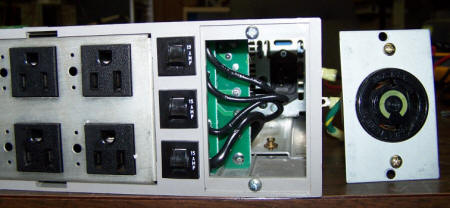 |
The R3000-XR comes with a high-current "Twist-Lock" AC connector
mounted on a plate. I decided that the six normal grounded AC
connectors would be enough outlets, and removed the plate. I'm
hopeful that this will provide enough ventilation for the two
switching supplies so that I don't have to punch a hole in the chassis
as I did with the R1500. |
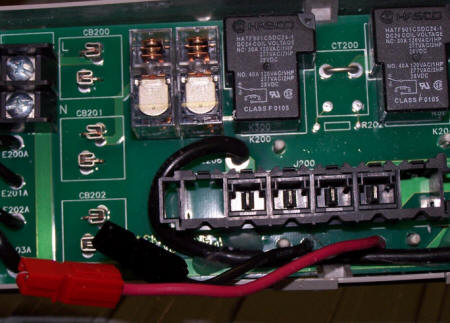 |
There's no good way to connect to the battery power terminals inside
the UPS. There's just nothing easily accessible. I could
have scraped insulation from the PC board and the ground wire, but I
decided instead to drill small holes in the rear PC board and solder the
additional wires directly to the battery terminals. I added the
short black and red wires shown, and put a 45A Anderson Powerpole
connector on each one. The PC board is a nuisance to remove -
everything snaps in and a combination of tools and more than the normal
complement of manipulative appendages is required to access the bottom
portion. |
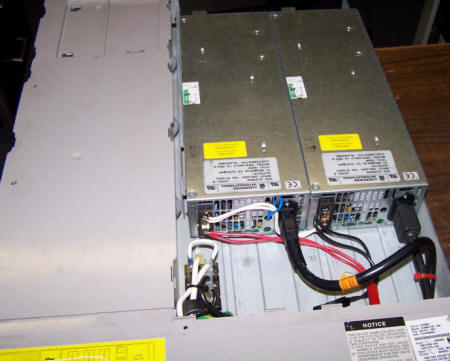 |
Here's one view of the final installation of the switchers in the
UPS chassis. I used two heavy-gauge wires in parallel for each of
the power connections. The white wire connects the negative
terminal of one switcher to the positive of the other, placing them in
series for double the voltage. They are adjusted to 48V at the
factory, giving a total of 96V. Since this is also the dropout
voltage of the UPS, they must be adjusted, and I used the provided pot
to set them to 52V each, giving 104V total, which should be a
comfortable margin. I would have liked to set them even higher,
but they have a non-adjustable overvoltage protection feature. The
supplies are diode-protected, so no harm will be done if an external
source of DC at the unit's nominal 120V is connected. |
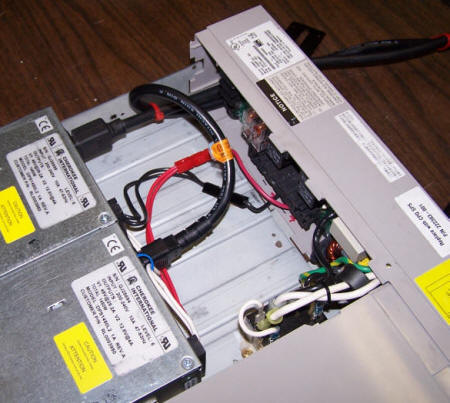 |
This is a view of the final assembly from another angle. The
heavy gage IEC line cords simply go through the hole left by removing
the Twist-Lock connector and mounting plate. They connect to the
outlet strip in the Prius. |
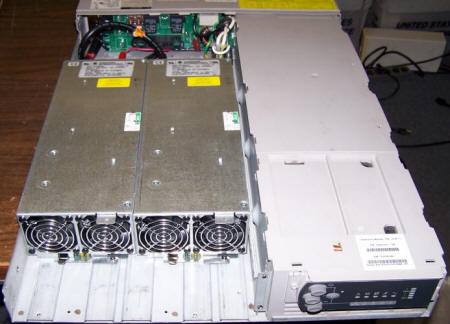 |
A front view of the installation before putting the top cover back
on. |
 |
The complete package weighs in at a bit over 50 pounds for 3kW of
AC. This is only 12 pounds more than the 1.5kVA "medium system."
The extra weight is from the somewhat longer chassis and, of course, the
second switching supply. The actual power electronics weigh about
the same, or maybe even less! |
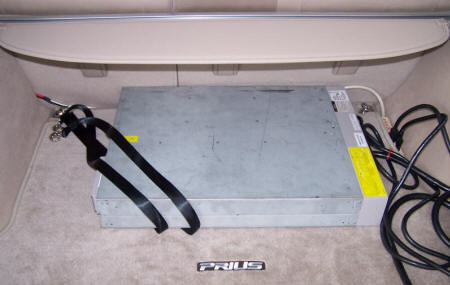 |
Here's the assembled 3kVA system in the trunk of the Prius. As
proof of my loss of sheet metal charisma, the two straps that fit
perfectly on the R1500XR unit don't quite make it around this one.
They're short by only an inch, and I'm stopping at the hardware store
for a small carabiner today. |
There is an odd problem with the R3000XR unit having to do with an
undocumented "feature" of the supply. It's a bit of a mystery as to why
the software works this way, but in the interest of full documentation, I'll
describe it here in case you're using this UPS in your PriUPS. The problem
has to do with "cold starting" the UPS from the switching supplies.
Incidentally, the R1500XR does NOT suffer from this problem. Here's the
info:
The R3000XR is documented to be capable of "cold start" and in fact it is.
I surmise that this "feature" was thrown in to protect against starting the UPS
when the batteries are dead, which is what they appear to be if the switchers
are shut down rather than the UPS turned off. I corresponded with HP
about this problem and they suggested that the control software supplied with a
new R3000XR might be able to work around this. I haven't tried it.
How thoughtful of the software to be so protective, and so meddlesome.













